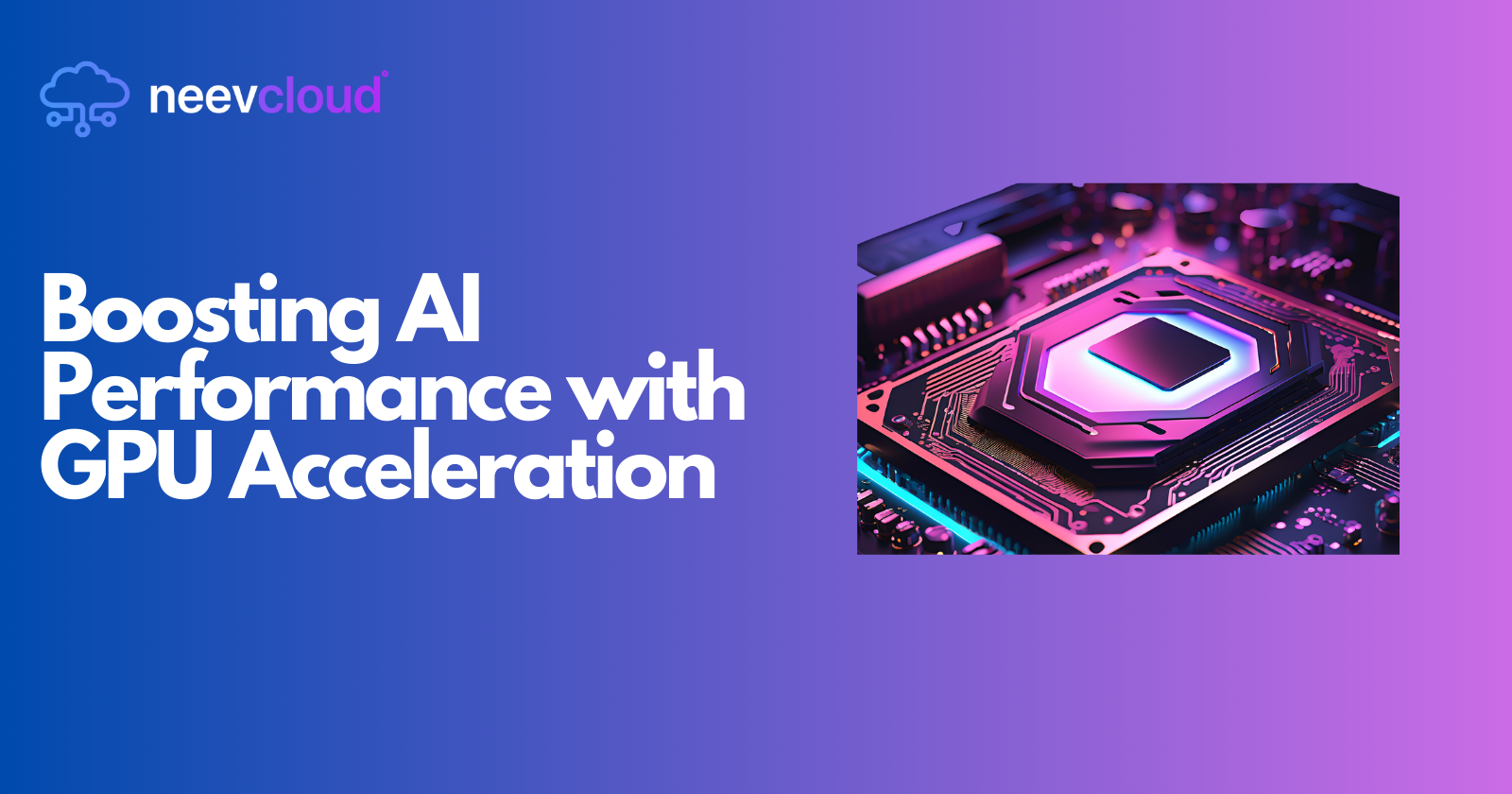Boosting AI Performance with GPU Acceleration
 Tanvi Ausare
Tanvi Ausare
In recent years, artificial intelligence (AI) and deep learning have surged to the forefront of innovation, transforming industries from healthcare to finance. One key enabler of this transformation is GPU acceleration. As demand for faster and more efficient AI training grows, leveraging specialized cloud infrastructure like AI Cloud and AI SuperCloud becomes essential. In this post, we’ll explore how GPU acceleration, combined with the right cloud technologies, provides the foundation for cutting-edge deep learning applications.
1. The Role of GPUs in AI and Deep Learning
Modern AI workloads require massive computational power, particularly when training complex deep learning models. GPUs (Graphics Processing Units) are designed to handle large-scale parallel computations, making them ideal for accelerating AI workloads.
Why GPUs?
Capable of executing thousands of parallel threads simultaneously.
Optimized for matrix operations, the core of neural network computations.
Deliver faster training for deep learning models compared to traditional CPUs.
GPUs in Deep Learning Frameworks:
TensorFlow and PyTorch have built-in support for GPU acceleration.
GPUs drastically reduce the time required for hyperparameter tuning and model experimentation.
Models like transformers and convolutional neural networks (CNNs) benefit immensely from GPU-optimized operations.
2. The Shift Toward Cloud for Deep Learning
Deploying AI infrastructure on-premises can be complex and costly. Cloud platforms provide an attractive alternative by offering scalable and on-demand access to GPU resources. This is where AI Cloud and AI SuperCloud come into play.
AI Cloud
Provides flexible, pay-as-you-go access to GPU instances.
Supports a wide range of AI workloads, including model training and inferencing.
Helps developers focus on building models instead of managing hardware infrastructure.
AI SuperCloud
Combines the power of multiple GPU clusters for high-performance computing (HPC).
Designed for large-scale deep learning models such as GPT, BERT, and LLaMA.
Offers distributed training capabilities, making it possible to train billion-parameter models efficiently.
3. Benefits of GPU Acceleration in the Cloud
Using cloud platforms specifically designed for AI workloads allows organizations to achieve better performance and scalability. Here are some advantages of GPU acceleration in AI Cloud and AI SuperCloud environments:
Performance Boost:
GPUs offer 10x or more speed improvements over CPUs for AI tasks.
Cloud platforms provide optimized hardware (e.g., NVIDIA A100 or H100 GPUs) for deep learning.
Scalability:
Scale up or down based on workload requirements.
Add more GPU instances on demand to accelerate training or inference jobs.
Cost-Efficiency:
Avoid capital expenditure on expensive on-premise GPU infrastructure.
Pay only for the resources consumed, reducing operational costs.
Accessibility:
Democratizes access to state-of-the-art AI tools for startups and enterprises alike.
Offers pre-configured environments with popular AI frameworks like TensorFlow, PyTorch, and Hugging Face.
4. Use Cases of AI Cloud and SuperCloud for Deep Learning
Several industries are benefiting from AI Cloud and GPU-accelerated deep learning. Let’s explore some use cases where these technologies make a significant impact:
Healthcare:
Medical image analysis with deep learning models (e.g., detecting tumors in MRI scans).
Accelerating drug discovery through protein folding simulations.
Finance:
Fraud detection using deep learning-based anomaly detection models.
Real-time risk assessment and high-frequency trading using AI algorithms.
Autonomous Vehicles:
Training convolutional neural networks for object detection and lane recognition.
Running complex reinforcement learning models for autonomous driving systems.
Natural Language Processing (NLP):
Fine-tuning large language models (LLMs) for chatbots and virtual assistants.
Sentiment analysis for customer service and social media monitoring.
5. Key Challenges of GPU Acceleration in the Cloud
While GPU acceleration on the cloud offers several advantages, it also presents challenges that organizations need to address:
Cost Management:
GPU instances are more expensive than standard compute resources.
Continuous monitoring and optimization are needed to avoid unnecessary expenses.
Data Security and Compliance:
Transferring sensitive data to the cloud requires robust security measures.
Ensure compliance with data privacy regulations (e.g., GDPR, HIPAA).
Network Latency:
Distributed training can introduce latency due to network bottlenecks.
Selecting cloud regions closer to users or employing high-bandwidth networking can mitigate this.
6. Best Practices for Using AI Cloud and AI SuperCloud for Deep Learning
To maximize the benefits of GPU acceleration in the cloud, organizations should follow some best practices:
Optimize Model Design:
Use model quantization and pruning techniques to reduce computational load.
Leverage pre-trained models to avoid training from scratch.
Automate Workflows:
Use tools like Kubernetes and MLflow for model deployment and monitoring.
Automate resource scaling based on workload demand with cloud-native solutions.
Experiment with Distributed Training:
Split large datasets across multiple GPU instances using data parallelism.
Implement model parallelism for training models that don't fit into a single GPU’s memory.
Monitor and Tune Performance:
Utilize cloud dashboards to monitor GPU utilization and identify bottlenecks.
Regularly tune hyperparameters and batch sizes to achieve optimal results.
7. The Future of AI and Deep Learning in AI SuperCloud
The evolution of AI SuperCloud opens new possibilities for deep learning, paving the way for advancements like:
AI-Powered Edge Computing:
Cloud-integrated edge devices will leverage smaller, GPU-powered models for real-time AI processing.
Applications in smart cities, industrial IoT, and 5G networks.
Autonomous Research Agents:
Cloud-based AI systems will perform autonomous experimentation, identifying novel solutions to complex problems.
Accelerating discoveries in materials science and climate modeling.
Generative AI at Scale:
Training advanced generative models (e.g., DALL·E or MidJourney) will rely on AI SuperCloud infrastructure.
Expanding creative applications across industries like design, entertainment, and marketing.
Conclusion
As the demand for AI and deep learning grows, GPU acceleration is becoming a crucial part of the equation. Cloud platforms like AI Cloud and AI SuperCloud provide businesses with the resources they need to train, deploy, and scale deep learning models efficiently. From healthcare to finance, the potential applications are limitless—and with the right strategies, organizations can harness the power of these technologies to stay ahead of the curve.
At NeevCloud, we are committed to empowering enterprises and developers by providing cutting-edge cloud infrastructure optimized for AI and deep learning. With AI Cloud and AI SuperCloud solutions, we aim to make high-performance AI accessible, scalable, and sustainable for businesses of all sizes.
Subscribe to my newsletter
Read articles from Tanvi Ausare directly inside your inbox. Subscribe to the newsletter, and don't miss out.
Written by
